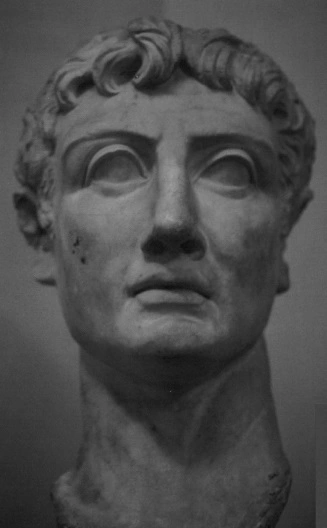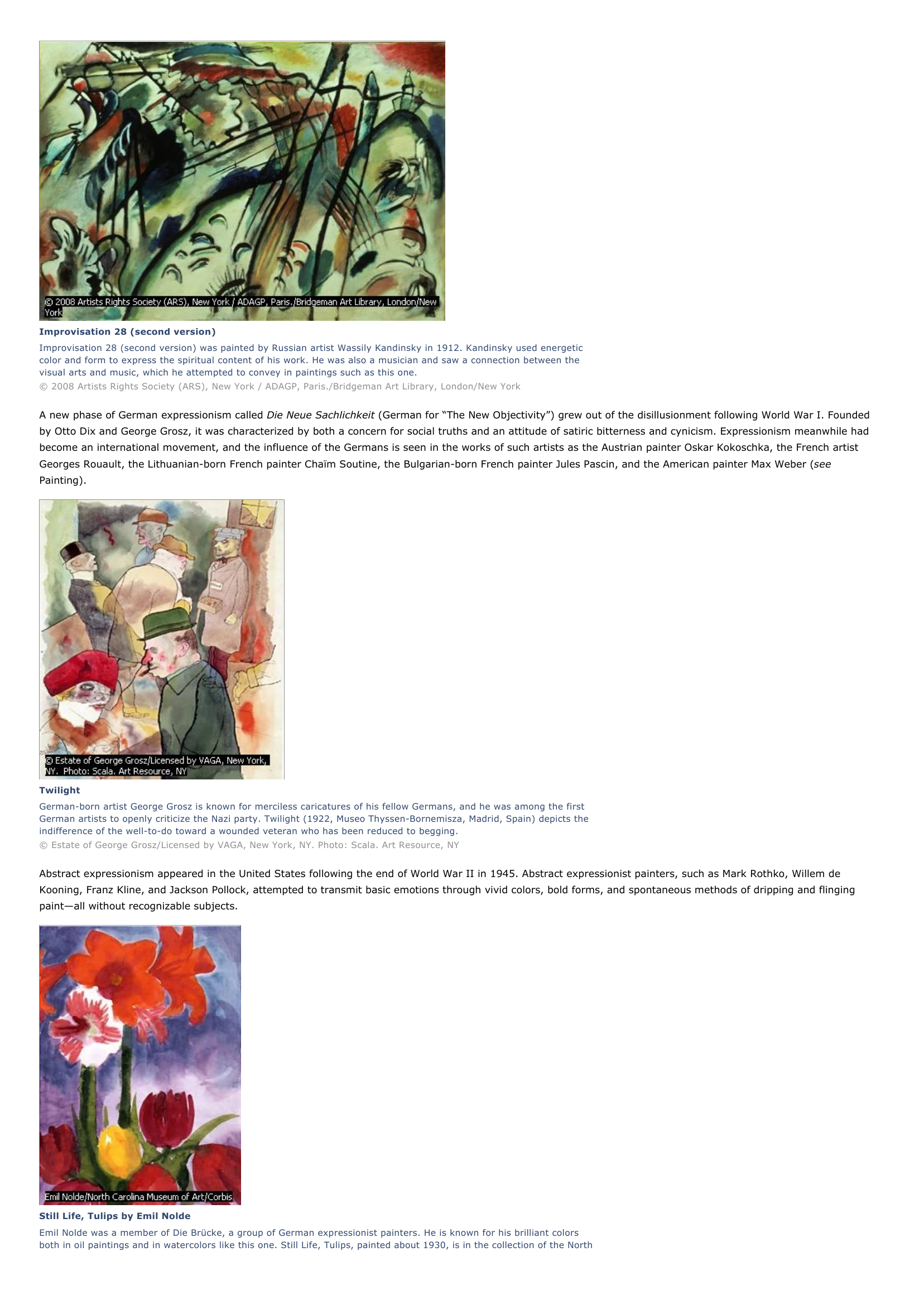
Expressionism I INTRODUCTION Auguste Rodin Regarded as the foremost sculptor of the 19th and 20th centuries, French artist Auguste Rodin captured both dynamic movement and inner psychological states. In 1880 he began work on the Gates of Hell, a large bronze door for the Musée des Arts Décoratif in Paris, France. Culver Pictures Expressionism, in the visual, literary, and performing arts, a movement or tendency that strives to express subjective feelings and emotions rather than to depict reality or nature objectively. The movement developed during the late 19th and early 20th centuries as a reaction against the academic standards that had prevailed in Europe since the Renaissance (1300-1600), particularly in French and German art academies. In expressionism the artist tries to present an emotional experience in its most compelling form. The artist is not concerned with reality as it appears but with its inner nature and with the emotions aroused by the subject. To achieve these ends, the subject is frequently caricatured, exaggerated, distorted, or otherwise altered in order to stress the emotional experience in its most intense and concentrated form. II PAINTING AND SCULPTURE The Scream Norwegian artist Edvard Munch produced powerful paintings and graphic works that portrayed the inner turmoil of his subjects. The Scream (1893), with its sinuous forms, violent colors, and screaming subject, is the most famous of his paintings. Munch's expressive and anguished works profoundly influenced the development of German expressionism. © 2008 The Munch Museum / The Munch-Ellingsen Group / Artists Rights Society (ARS), New York./Bridgeman Art Library, London/New York Although the term expressionism was not applied to painting until 1911, the qualities attributed to expressionism are found in the art of almost every country and period. Some Chinese and Japanese art emphasizes the essential qualities of the subject rather than its physical appearance. Painters and sculptors of medieval Europe exaggerated their work for the Romanesque and early Gothic cathedrals to intensify the spiritual expressiveness of the subjects. Intense religious emotions expressed through distortion are found also in the 16th-century works of the Spanish painter El Greco and the German painter Matthias Grünewald. In the late 19th and early 20th centuries the Dutch painter Vincent van Gogh, the French artist Paul Gauguin, and the Norwegian painter Edvard Munch used violent colors and exaggerated lines to obtain intense emotional expression. The most important expressionist group in the 20th century was the German school. The movement was originated by the painters Ernst Ludwig Kirchner, Erich Heckel, and Karl Schmidt-Rottluff, who in 1905 organized a group in Dresden called Die Brücke (German for "The Bridge"). They were joined in 1906 by Emil Nolde and Max Pechstein and in 1910 by Otto Müller. In 1912 this group exhibited paintings along with a Munich group that called itself Der Blaue Reiter (German for "The Blue Rider"). The latter included the German painters Franz Marc, August Macke, Gabriele Münter, and Heinrich Campendonk; the Swiss artist Paul Klee, and the Russian painter Wassily Kandinsky. This phase of expressionism in Germany was marked by the conscious exposition of emotions and a heightened sense of the possibilities for expressive content. Die Brücke was dissolved by 1913, and World War I (1914-1918) halted most group activity. The fauves (see Fauvism) in France, as well as the French painter Georges Braque and the Spanish artist Pablo Picasso, at a certain period of their development, were influenced by expressionism (see Modern Art). Improvisation 28 (second version) Improvisation 28 (second version) was painted by Russian artist Wassily Kandinsky in 1912. Kandinsky used energetic color and form to express the spiritual content of his work. He was also a musician and saw a connection between the visual arts and music, which he attempted to convey in paintings such as this one. © 2008 Artists Rights Society (ARS), New York / ADAGP, Paris./Bridgeman Art Library, London/New York A new phase of German expressionism called Die Neue Sachlichkeit (German for "The New Objectivity") grew out of the disillusionment following World War I. Founded by Otto Dix and George Grosz, it was characterized by both a concern for social truths and an attitude of satiric bitterness and cynicism. Expressionism meanwhile had become an international movement, and the influence of the Germans is seen in the works of such artists as the Austrian painter Oskar Kokoschka, the French artist Georges Rouault, the Lithuanian-born French painter Chaïm Soutine, the Bulgarian-born French painter Jules Pascin, and the American painter Max Weber (see Painting). Twilight German-born artist George Grosz is known for merciless caricatures of his fellow Germans, and he was among the first German artists to openly criticize the Nazi party. Twilight (1922, Museo Thyssen-Bornemisza, Madrid, Spain) depicts the indifference of the well-to-do toward a wounded veteran who has been reduced to begging. © Estate of George Grosz/Licensed by VAGA, New York, NY. Photo: Scala. Art Resource, NY Abstract expressionism appeared in the United States following the end of World War II in 1945. Abstract expressionist painters, such as Mark Rothko, Willem de Kooning, Franz Kline, and Jackson Pollock, attempted to transmit basic emotions through vivid colors, bold forms, and spontaneous methods of dripping and flinging paint--all without recognizable subjects. Still Life, Tulips by Emil Nolde Emil Nolde was a member of Die Brücke, a group of German expressionist painters. He is known for his brilliant colors both in oil paintings and in watercolors like this one. Still Life, Tulips, painted about 1930, is in the collection of the North Carolina Museum of Art in Raleigh. Emil Nolde/North Carolina Museum of Art/Corbis Expressionist sculpture has its roots in the work of the 19th-century French sculptor Auguste Rodin, who expressed the inner states of his subjects within representational forms. He strongly influenced the work of his assistant Antoine Bourdelle, the Croatian sculptor Ivan Me?trovi?, the British sculptor Jacob Epstein, and the German Ernst Barlach. All of their work, expressed in the human figure, involves various forms of distortion, such as exaggeration, elongation, and massiveness. III LITERATURE, DRAMA, AND FILM The objectives of expressionism in literature, notably in the novel and the drama, are similar to those in art. The characters and scenes are presented in a stylized, distorted manner with the intent of producing emotional shock. The German painter Alfred Kubin, a member of Der Blaue Reiter, wrote one of the earliest expressionist novels, Die Andere Seite (The Other Side). He exerted a profound influence on the Czech novelist Franz Kafka and other writers. The early expressionist playwrights, August Strindberg of Sweden and Frank Wedekind of Germany, exerted an international influence on the next generation of playwrights. These included the Germans Georg Kaiser and Ernst Toller, the Czech Karel ?apek, and the Americans Eugene O'Neill and Elmer Rice. Expressionist drama gave rise to a new approach to staging, scene design, and directing. The object was to create a totally unified stage picture that would increase the emotional impact of the production on the audience. Among prominent directors were the Germans Max Reinhardt and Erwin Piscator and the Russian Vsevolod Meyerhold. Set designers such as Edward Henry Gordon Craig of Britain and Robert Edmond Jones of the United States used techniques similar to those of expressionist painters to provide visual stimulation consonant with the dramas. Expressionist painting and drama also influenced the cinema, as can be seen in the German films The Cabinet of Dr. Caligari (1919), with its nightmarish perspectives and masklike makeup, and The Last Laugh (1924), notable for the brilliant use of lighting and camera angles to convey the bitter story. IV MUSIC Expressionism in music, which crested between the two world wars, gave voice to the anxieties, inner terrors, and cynicism of human life in the 20th century through emotionally intense, musically complex, and carefully structured works. Conventional techniques were distorted, and "pretty" harmonies were avoided in favor of dissonant, complex ones used with great power. The music is often atonal or distorts traditional tonality. Polyphony (interweaving of melodic lines) is often dense, and melody in the traditional sense is often unrecognizable. The roots of expressionism can be seen in the works of late romantic composers such as Richard Wagner of Germany, and in the compositions of postromantics such as the Austrian composer Gustav Mahler. Examples include two early operas by the German composer Richard Strauss, Elektra (1909) and Salome (1905); certain works of the Austrian composer Arnold Schoenberg, the dramatic scenes Erwartung (Anxiety, 1909) and Die Glückliche Hand (The Lucky Hand, 1913), and the song cycle Pierrot Lunaire (1912); and the operas of the Austrian composer Alban Berg, Wozzeck (1925) and Lulu (1935; first full performance, 1979). Other composers with expressionist elements include Paul Hindemith of Germany, Béla Bartók of Hungary, and Sergey Prokofiev of Russia. Microsoft ® Encarta ® 2009. © 1993-2008 Microsoft Corporation. All rights reserved.



































